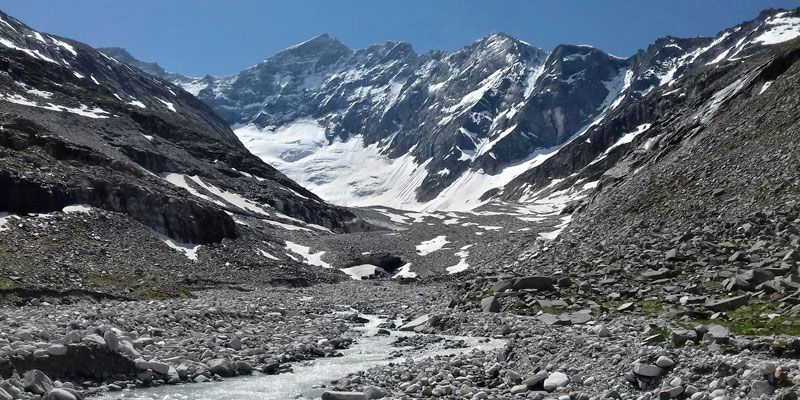
Researchers have called for urgent global action to address the effects of rapidly shrinking glaciers on ecosystems further downstream.
Although the impact of melting glaciers on sea levels has received much attention, a team of academics have outlined other effects that will have a significant impact on freshwater and near-shore marine systems downstream.
These range from significantly altered river flows and sediment levels to the unexpected impact of “legacy” industrial pollutants, hitherto locked up in glaciers, being released into ecosystems downstream along with glacial meltwater.
The scientists call for a renewed focus on finding ways to adapt and mitigate against this impact.
Dr Lee Brown, a freshwater ecologist from the University of Leeds’ School of Geography, co-authored a paper published in Proceedings of the National Academy of Sciences today.
He said: “Societies in many regions depend on glacier-fed rivers for drinking water, hydropower, tourism and water quality regulation. Suitable management strategies will need to be developed and adopted to mitigate the impacts of profound changes in glacial runoff.”
“Careful planning will be needed because, for example, building new reservoirs may solve water supply issues but impact negatively on landscape character and tourism.”
Unexpected impact
Professor Alexander Milner, from the University of Birmingham, led the research. He added: “We don’t believe that the sheer enormity of the impact of glacial shrinkage on downstream ecosystems has been fully integrated to date. The breadth of risk to our current way of life is vast. The first step must be a realignment in how we view glacial shrinkage, and a research agenda that acknowledges the risk to regions likely to be most affected.”
The changes in river hydrology and morphology due to climate-induced glacier loss are projected to be the greatest of any hydrological system. There will be significant changes to flow regimes in glacierised watersheds, as glacial runoff decreases and flow becomes more dependent on unpredictable precipitation events and snow melt. Glacier shrinkage will alter sediment transport as well as biogeochemical and contaminant fluxes from rivers to oceans.
An unexpected impact of glacier shrinkage is the liberation of contaminants, including industrial pollutants such as black carbon and associated compounds, mercury, pesticides, and other persistent organic pollutants. There is uncertainty in the release of these legacy contaminants from glacierised areas, though their transport to downstream systems by meltwater will eventually reduce as glacial ice volume shrinks.
These effects will profoundly influence the natural environment, including many facets of biodiversity, and the ecosystem services that glacier-fed rivers provide to humans, particularly provision of water for agriculture, hydropower and consumption.
The authors outlined four key recommendations they believe should underpin a global research agenda involving interdisciplinary research:
- Detailed mapping of glacier mass change from new imagery and processing technologies
- Global monitoring and census efforts of key biogeochemical variables, contaminant loads and biodiversity in glacier-fed rivers via widespread monitoring networks with standardised sampling methods.
- Valuation of the provision, regulation and cultural impact of glacier-related ecosystem services (particularly contaminant loads and commercial and sport fishery salmon habitats).
- Adaptive management plans for glacier change in the most sensitive regions, including international legislation to protect strategic glacier-derived water resources.
Glaciers cover almost 10% of the Earth’s land surface but are shrinking rapidly across most parts of the world. The area of land they occupy will decrease significantly by the end of this century. The largest individual contributions to global glacier mass loss come from the glaciers of the Gulf of Alaska, the Canadian Arctic, and the ice sheet peripheries of Greenland and Antarctica.
But the glaciers with the most negative mass balances are located in the European Alps and at low latitudes in the South American Andes. In the European Alps, atmospheric warming has been pronounced in the last 30 years, especially during the summer months. When combined with decreased snowfall, this has led to a 54% loss of ice area since 1850. Current projections suggest that just 4–13% of the 2003 European Alps ice area will remain by 2100.
Further information
Image shows Odenwinkelkees in the Austrian Alps. Picture by Dr Lee Brown.
For further information or interviews, email the University of Leeds press office at pressoffice@leeds.ac.uk.
“Glacier shrinkage driving global changes in downstream systems” by Alexander M. Milner, Kieran Khamis, Tom J. Battin, John E. Brittain, Nicholas E. Barrand,Leopold Füreder, Sophie Cauvy-Fraunié, Gísli Már Gíslason, Dean Jacobsen, David M. Hannah, Andrew J. Hodson, Eran Hood, Valeria Lencioni, Jón S. Ólafsson, Christopher T. Robinson, Martyn Tranter, and Lee E. Brown, was published today in Proceedings of the National Academy of Sciences.